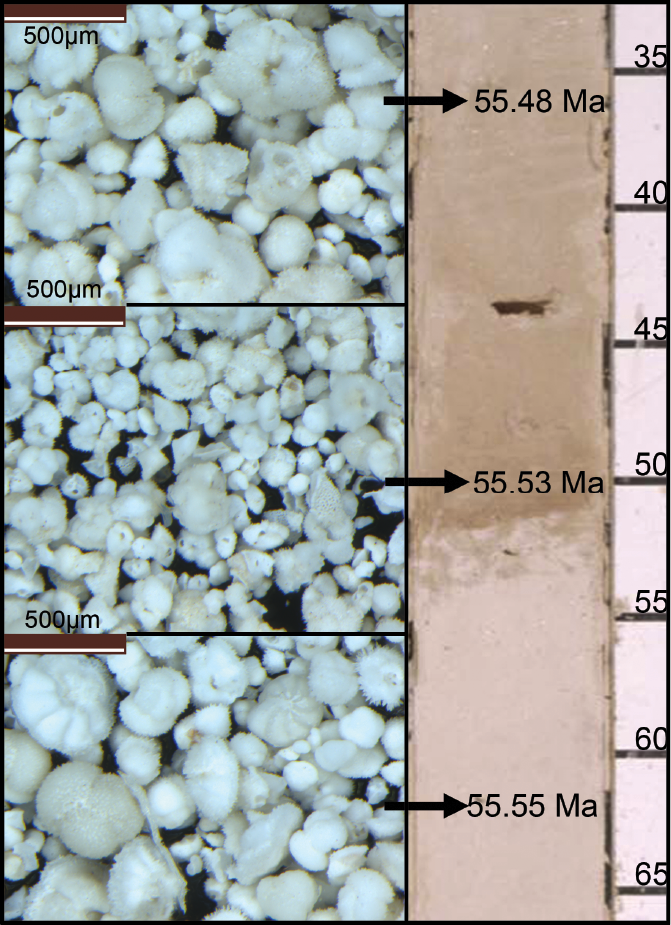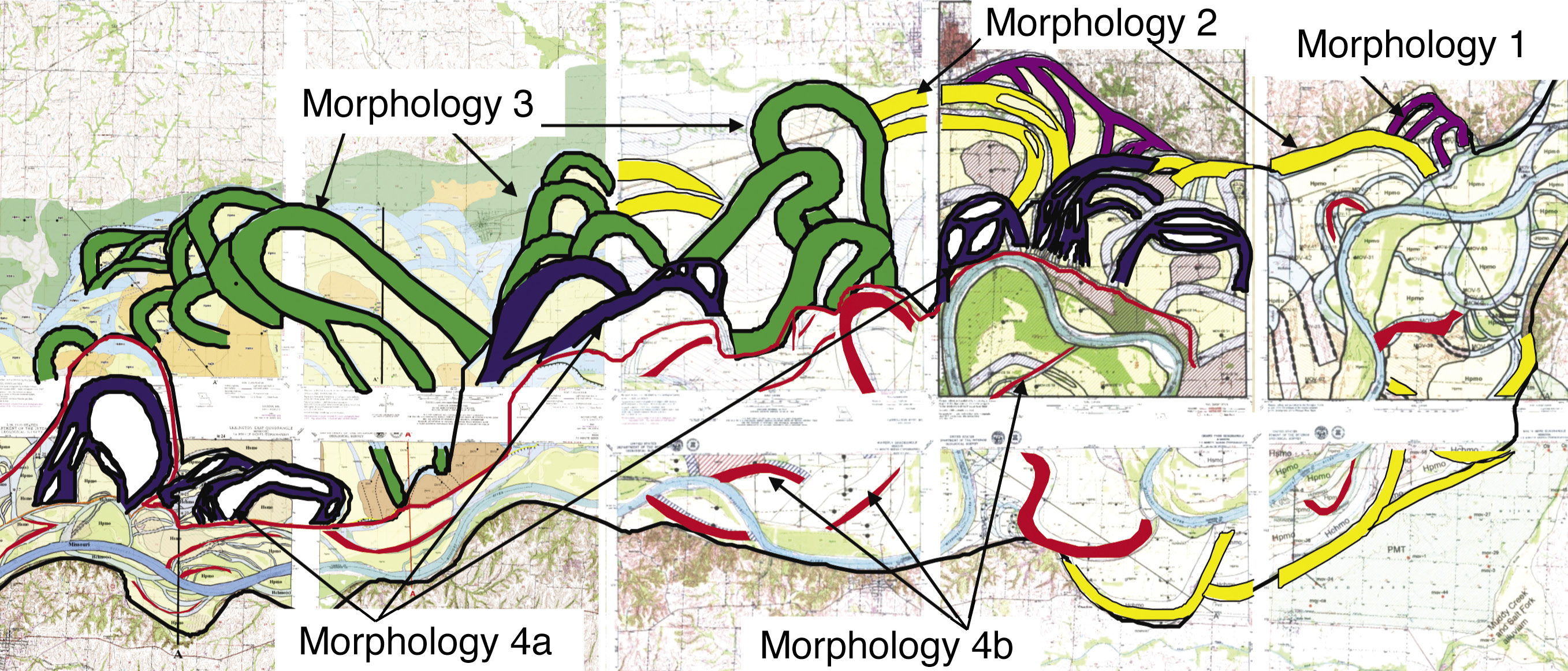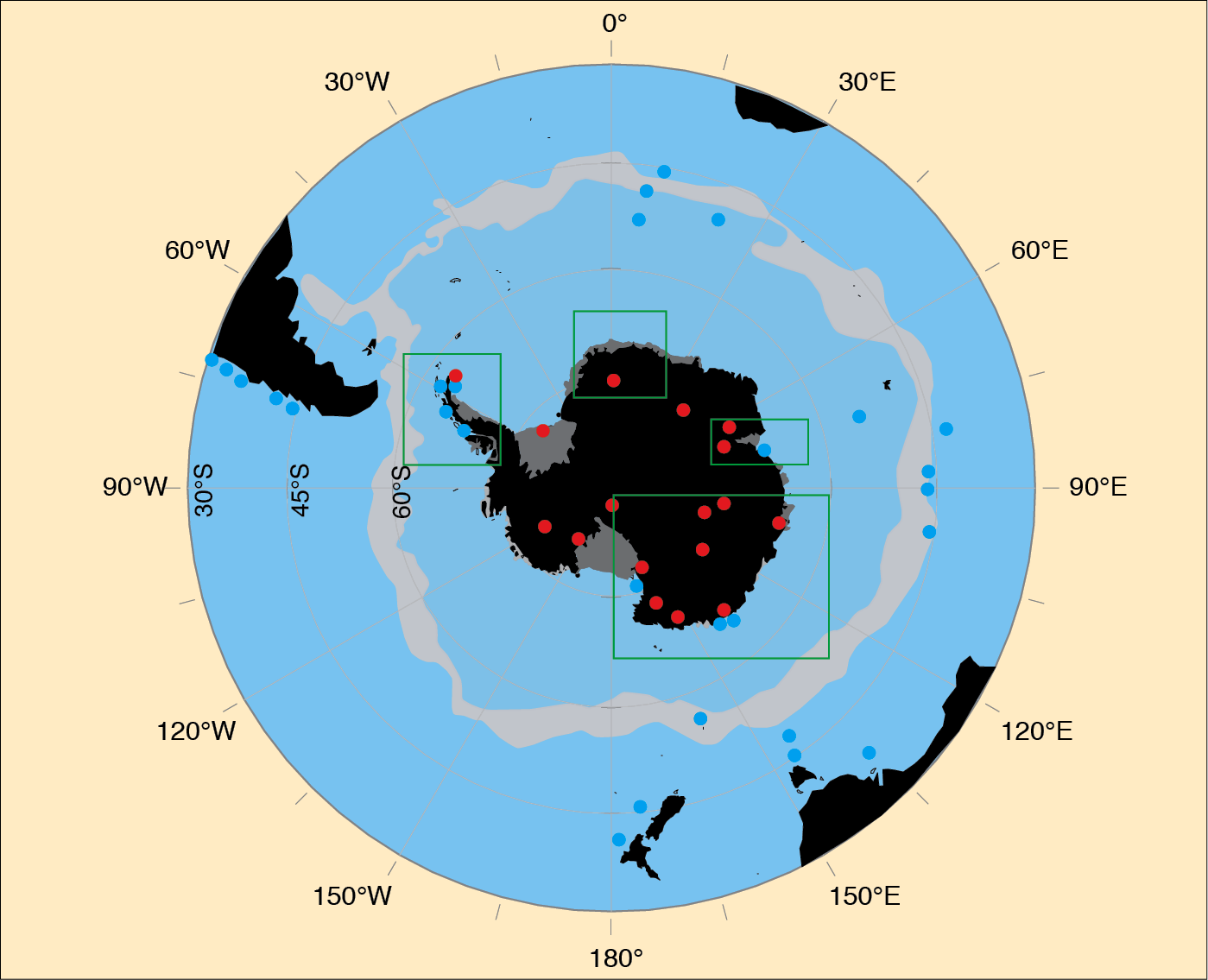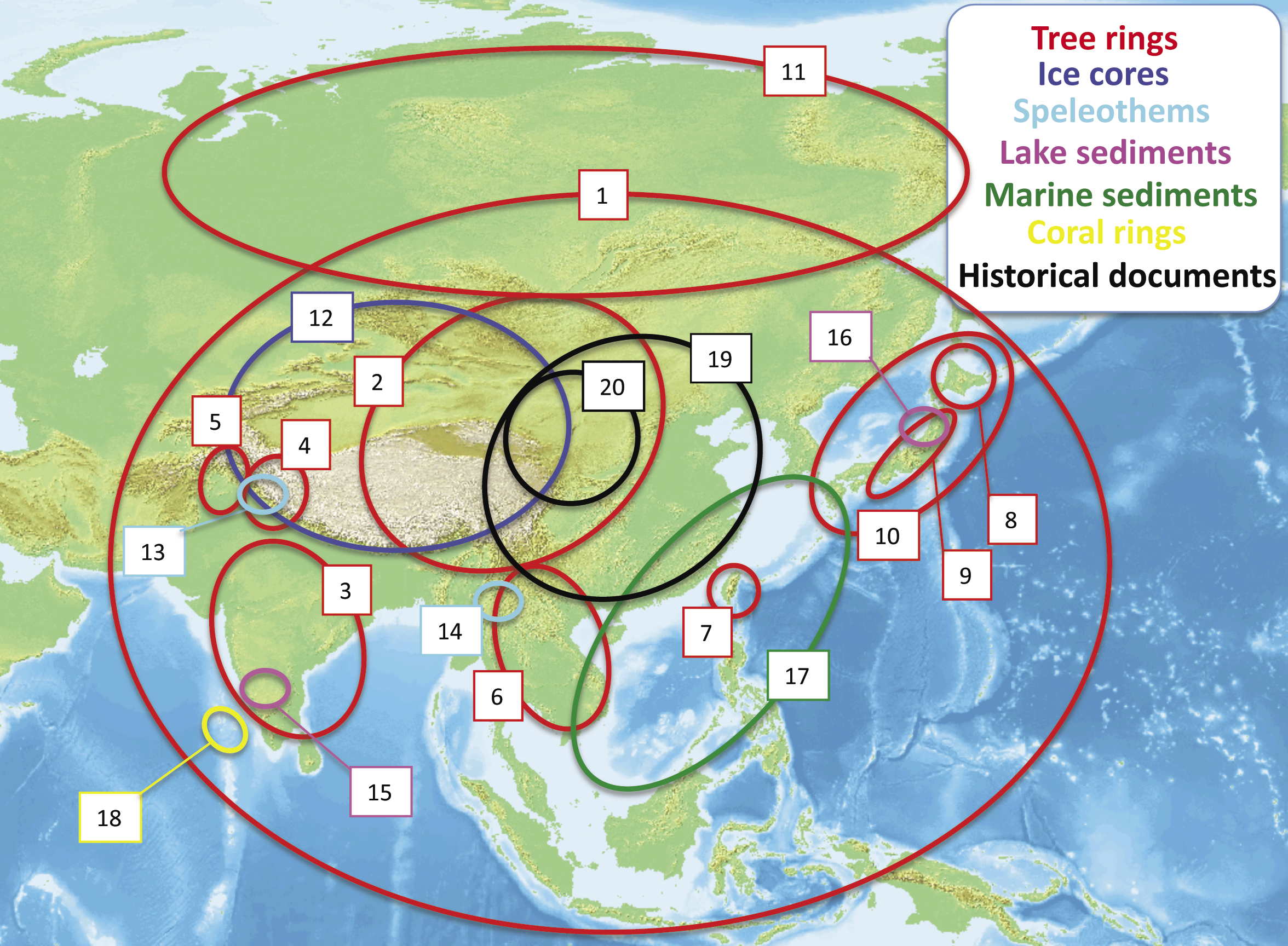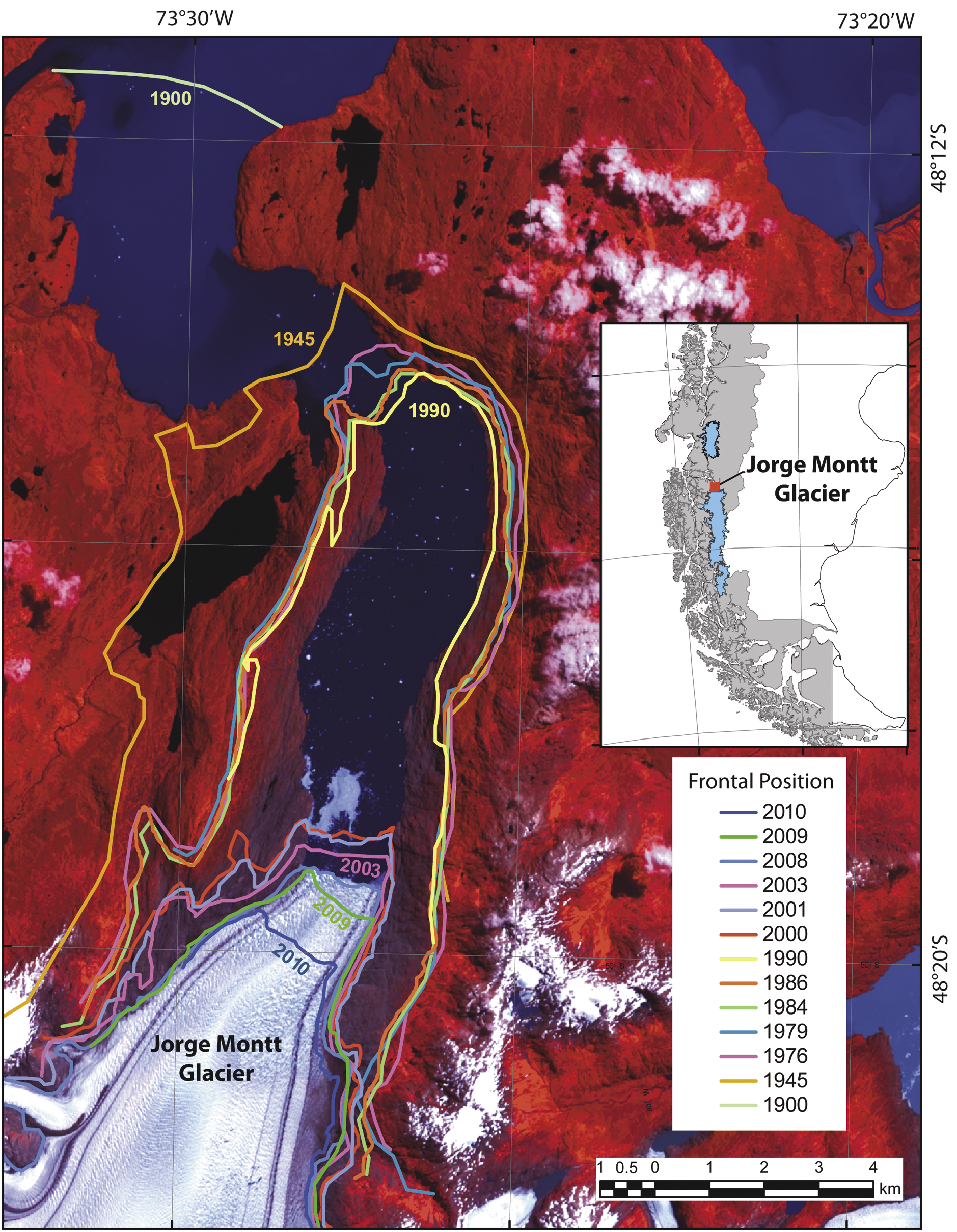- Home
- Taxonomy
- Term
- PAGES Magazine Articles
PAGES Magazine articles
Publications
PAGES Magazine articles
2011
Past Global Changes Magazine
Fekri A. Hassan
Institute of Archaeology, University College London, UK; fekrihassan hotmail.com
hotmail.com
Records of Nile flood discharge from AD 930 to 1450 reveal pronounced variability in the frequency of extreme floods due to differential influence of global climatic forcing mechanisms on the two main catchment areas of the Nile tributaries, namely Equatorial Africa and the Ethiopian Highlands.
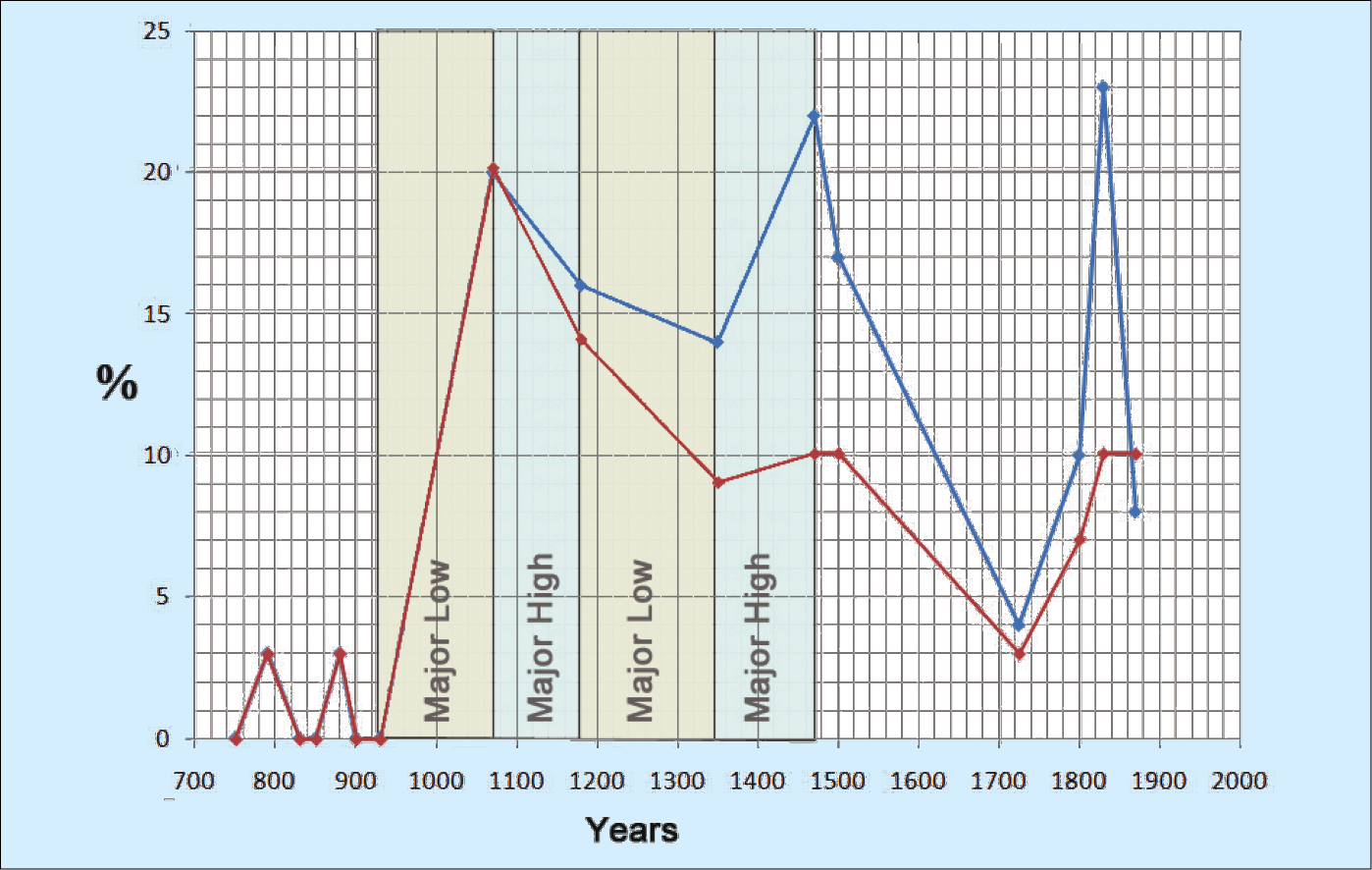 |
|
Figure 1: Percentage of anomalously low floods (red) and of both extremely low and high floods (blue) superimposed on the major episodes of low and high Nile flood discharge. |
A record of variations in Nile flood discharge dating back to the 7th century AD (Hassan, 1981) provides a basis for analyzing the relationship between Nile floods, climate change, and famines in Egypt during the Medieval Climate Anomaly (MCA). The volume of Nile flood discharge, as well as its seasonality, is primarily governed by the impact of climate on rainfall over the Nile catchment areas in Ethiopia and Equatorial Africa. Throughout Egyptian history, Nile floods influenced food production, which depended on Nile water for irrigation and the amount of silt annually deposited on the floodplain. Correction and calibration of the primary historical annual records of Nile minimal and maximal flood levels, followed by an analysis of the calibrated data reveal that Nile floods discharge during the MCA interval from AD 930 to 1350 were not constant. Instead, this period is characterized by multi-decadal long episodes of major low Nile flood levels from AD 930 to 1070, and from AD 1180 to 1350, as well as periods of major high Nile flood levels from AD 1070 to 1180 and from AD 1350 to 1470 (Fig. 1).
In addition, examination of the frequency of periods of anomalously extreme Nile floods (i.e., annual floods with unusually high or low levels) with known historical crises (Hassan, 2007) reveals that the onset of the MCA was marked by a dramatic increase of extreme low floods. The percentage climbs from 0-3% to 20% during the period from AD 930 to 1070 and to 14% from AD 1070 to 1180, in spite of an overall increase of the volume of flood discharge during that latter period. Subsequently, from AD 1180 to 1350, the number of extremely high floods increased at the expense of extremely low floods (Fig. 1). This period, characterized in general by a decrease in Nile flood discharge, coincides with the epic droughts that occurred from AD 1209 to 1350 in Californian mountain ranges as documented by tree stumps (Stine, 1994), suggesting a global climatic teleconnection. These droughts, according to Knox (1993), were apparently associated with changes in mean global annual temperature of 1-2°C. Nevertheless, apparently slight climatic changes in mean global temperature from the 9th to the 15th century were associated with pronounced hydrological responses. This is confirmed by the simulation of the hydrology of the Nile in response to different climate change scenarios (Conway and Hulme, 1996): precipitation anomalies were found to produce larger changes in runoff of about threefold magnitude. The high sensitivity of Nile flood discharge to changes in precipitation is further confirmed by recent historical changes with a 20th century (AD 1900-1984) average of 85 billion cubic metres compared to 110 billion cubic meters from AD 1870 to 1899 (Said, 1993).
The impact of fluctuations in Nile flood discharge during the MCA on the geomorphology of the flood plains is attested by the dramatic changes in the area of the capital city Cairo during this period (Hassan, 1997). Until AD 942, the eastern bank of the Nile floodplain was narrow and restricted to the area currently known as Old Cairo (Misr al-Qadima). Almost all of the area now occupied by the city was created in the ensuing period from AD 942 to 1403.
Comparison of the variations in Nile flood discharge with proxies of the North Atlantic Oscillation (NAO; Jansen and Koç, 2000; Baker et al., 2000) demonstrate a remarkable coherence between the fluctuations of Nile flood discharge and variations in North Atlantic sea surface temperature (SST). In general, variations in Norwegian Sea summer SST from AD 910 to 1070, from AD 1180 to 1340, and from AD 1400 to 1500 are inversely correlated with the fluctuations in Nile flood maxima (Jansen and Koç, 2000). By contrast, the Norwegian Sea summer SST variations are positively correlated with the fluctuations in Nile flood maxima from AD 800 to 910, from AD 1070 to 1180, and from AD 1700 to 1800. This “flip-flop” relationship is also manifested when variations in summer sea surface temperatures at Vøring Plateau off central Norway (Jansen and Koç, 2000) are compared with the Nile flood discharge, albeit not synchronously (Hassan, 2007). However, from AD 930 to 1010 and again from AD 1200 to 1350, as well as from AD 1400-1500 and AD 1700-1900 the temperatures at Vøring Plateau are inversely correlated with the height of Nile flood maxima. By contrast, from AD 800 to 850, from AD 1070 to 1180, and again from AD 1350-1400 the relationship is concordant (Hassan, 2007).
Nile flood discharge was also found to be in concordance with the Indian monsoons (Zickfeld et al., 2005), co-varying positively, except for the period from ca. AD 850 to 1080, when they are inversely correlated (Hassan, 2007). This may be in part related to the effect of ENSO and the extreme El Niño events between AD 967 and 1096, which often cause a reduction in Nile flood discharge (Quinn, 1992). Indeed, Nile discharge was low from AD 930 to 1070.
An understanding of the variations in Nile flood discharge must take into consideration the various global and local climatic variables influencing rainfall in the main sources of the Nile. Correlations with proxies of climate change elsewhere are also subject to the peculiarities of the proxies, the integrity of the evidence, and their locations. In this respect, it is particularly important to realize that the main catchment areas of the Nile tributaries—the Ethiopian Highlands (10°N) and the Equatorial Plateau (equator) are more than 1000 km apart and are influenced by different climatic regimes, and that precipitation in the catchments is influenced by the proximity to oceans, highland topography, land surface moisture, lakes and swamps. East Africa, one of the main sources of the Nile, is influenced by ENSO, and the SST of nearby Indian and Atlantic oceans. Farther North, the effect of NAO is more pronounced (Dore, 2005). Zhang and Delworth (2006) concluded that multi-
decadal variability in the Atlantic Ocean could cause observed multidecadal variations of Sahel and Indian summer rainfall. Street-Perrott and Perrott (1990) observed that several prolonged droughts in the Sahel during the past 14 ka were associated with large injections of freshwater into the northern Atlantic Ocean.
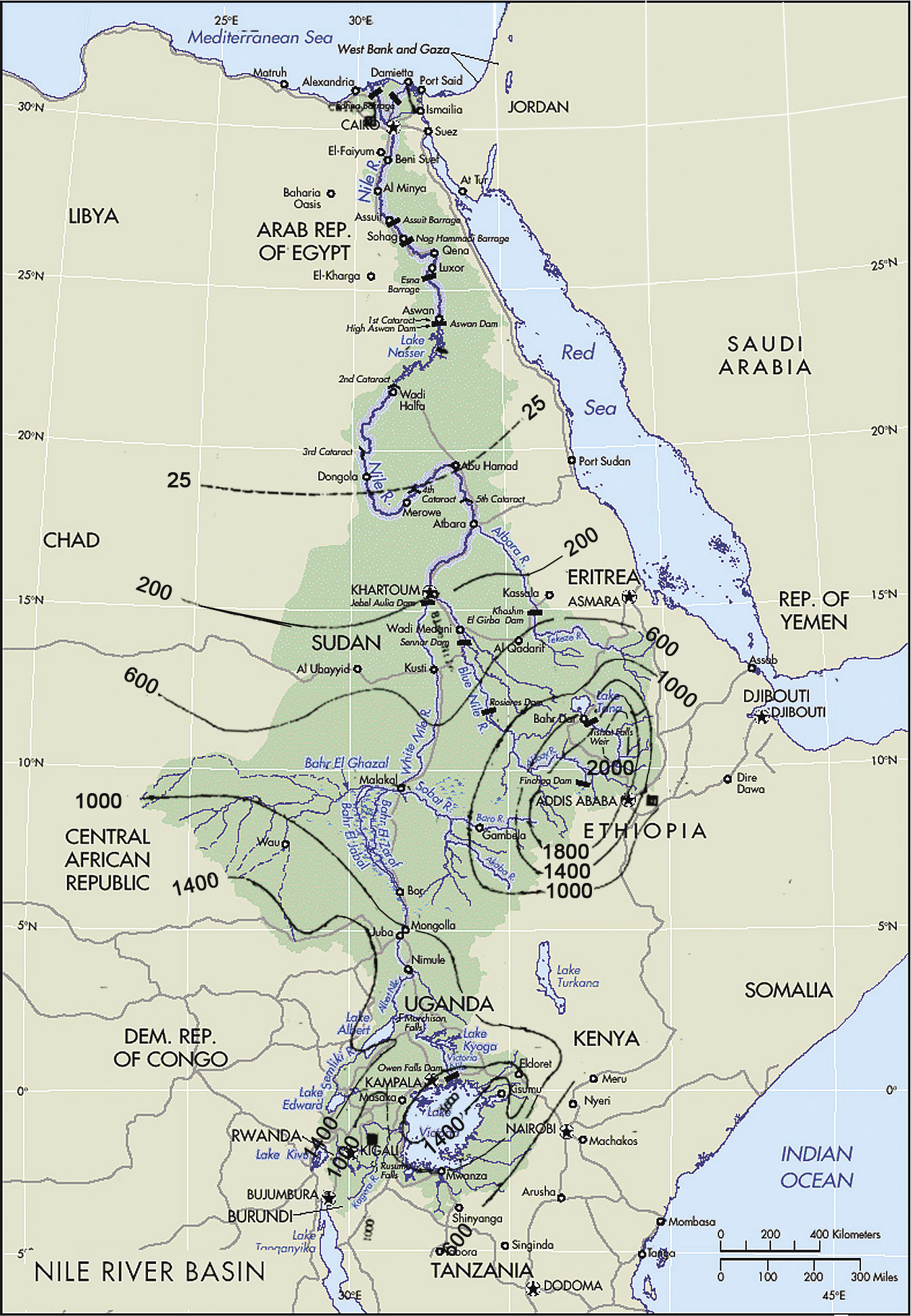 |
|
Figure 2: Nile River Basin showing mean annual rainfall in mm in the main Nile catchment areas in Ethiopia and Equatorial Africa. |
Using proxy data from Scotland and Morocco, Trouet et al. (2009) found persistent positive NAO during the MCA, resulting in stronger than average westerlies across the mid-latitudes and to a northward migration of the Intertropical Convergence Zone, affecting rainfall both in Equatorial East Africa and Ethiopia (the main water sources of the Nile; Fig. 2). This may explain the two wet episodes from AD 1070 to 1180 and again in the transition to the Little Ice Age from AD 1350 to 1470. However, this modality was interrupted by a low discharge episode from AD 1180 to 1350.
The Nile record clearly indicates that a distinct anomaly marked by extremely low floods and an overall diminution in Nile flood discharge lasted from AD 930 to 1070 (Fig. 1). Although the frequency of total extreme floods (blue line) persisted, there was a shift to a higher percentage (ca. +10% from AD 900 to 1350) of extremely high floods relative to extremely low floods (red line). Even though a period of relatively high flood discharge lasted from AD 1070 to 1180, a return to lower flood discharge occurred from AD 1180 to 1350.
By AD 1350 and until 1470, coinciding with a transition to the Little Ice Age, the Nile flood discharge was relatively high. This was associated with an increase in water flow from Ethiopia relative to that from Equatorial Africa (Hassan, 1981). These results indicate that Nile flood discharge in the Main Nile is influenced by multiple variables associated with the differential effects of global climatic mechanisms, such as NAO and ENSO, on the catchment areas in Equatorial Africa and the Ethiopian Highlands. Throughout the period from AD 950 to 1350, famines and plagues have had an adverse effect on society. The famines were in numerous instances caused by clusters of deficient Nile flood discharge, sometimes at close intervals. The deleterious impact of the fluctuations in Nile flood discharge were compounded by the impact of extremely high and low Nile flood discharges on the geomorphology of the channel and floodplain, influencing land use. Shifts in the relative contribution from the Equatorial and Ethiopian tributaries characterized by different rainfall seasons would have also negatively influenced agricultural food production.
references
For full references please consult: http://pastglobalchanges.org/products/newsletters/ref2011_1.html
Publications
PAGES Magazine articles
2011
Past Global Changes Magazine
Henry F. Diaz1, R. Trigo2, D. Barriopedro2, E. Xoplaki3, M. Hughes4and M.E. Mann5
1Climate Diagnostics Center, NOAA/ESRL, Boulder, USA; Henry.F.Diaz noaa.gov
noaa.gov
2Instituto Dom Luiz (IDL), University of Lisbon, Portugal
3Institute of Geography, University of Bern, Switzerland
4School of Natural Resources and the Environment, University of Arizona, Tucson, USA
5Department of Meteorology, Pennsylvania State University, University Park, USA
Lisbon, Portugal, 22-24 September 2010
In recent years, an increasing number of studies have been published describing elements of the Medieval Climate Anomaly (MCA). The general time frame for this epoch is generally taken to span from ca. 950-1300 AD. In order to assess the most updated and comprehensive characterization of the MCA period at regional and global scales, a symposium was organized and held in Lisbon, in September 2010. The symposium topics, within the framework of the PAGES 2k Network, are at the interface of Regional Climate Dynamics and Global Earth-System Dynamics (PAGES Foci 2 and 3), and overlap with the goals of Cross-Cutting Theme 2 (Proxy development, calibration, validation) and Cross-Cutting Theme 3 (Modeling).
The main objective of the 3-day symposium was to revisit the MCA by incorporating widespread and continuous paleoclimatic evidence in a homogeneous and consistent manner, and to scale it against the instrumental temperature record to allow a meaningful quantitative comparison in the magnitude of warming against the 20th-century pace. The déjà-vu title was chosen on purpose, as the organizers wanted to revisit the question posed already in 1994 by Hughes and Diaz in their Climatic Change review “Was there a Medieval Warm Period, and if so, where and when?”, taking into account that the latest IPCC report in 2007 (WG1) emphasizes the same ambivalence: “Regionally restricted evidence by itself, … is of little practical relevance to the question of whether climate in medieval times was globally as warm or warmer than today”.
The symposium, attended by 35 participants from 10 different countries including a mix of senior scientists and early career researchers, was divided in two parts: 1) Establishing the MCA Epoch as a Distinct Period, and 2) Climate Reconstruction Tools and Numerical Modeling of the MCA Climate. The first part focused on already existing and new proxies capable of resolving temperature changes in the last two millennia and covering a wide spectrum of regions (R. Bradley), including Tropical Pacific (K. Cobb), the Mediterranean basin (E. Xoplaki), western Europe (J. Guiot; D. McCarroll; A. Moreno), North America (J. Overpeck; A. Viau), the North Atlantic (G. Miller), Greenland (B. Vinther), the Arctic (D. Fisher; D. Kaufman) and South America (J. Luterbacher). Other authors provided a wider picture on the spatial and temporal extension of the MCA event (D. Fleitmann; M. Hughes; P. Jones; F. Lungqvist; M. Mann) or the underlying large-scale dynamics associated with the MCA and the LIA period (R. D’Arrigo; V. Trouet; E. Wahl; H. Wanner). The second part of the symposium was mostly devoted to the latest results obtained by the modeling community (D. Shindell; N. Graham; F. González-Rouco), emphasizing the need for better assimilation procedures (H. Goosse), capacity to reproduce major drought and wet periods (R. Seager) but also reproduction of large-scale patterns such as the AMO (R. Oglesby) and blocking (D. Barriopedro), as well as the need to improve the characterization of the solar activity variability (R. Trigo).
In summary, in answer to the question posed above regarding the spatial and temporal scales of the MCA, the general consensus of the participants is that in the past 15 years additional evidence has become available of a climatic anomaly occurring during the time interval ca. 900-1300 AD, albeit with important differences regarding the timing and spatial extent. The participants also stressed that a Northern Hemisphere or global mean value is of less relevance when looking at the regional spatial scales where the impacts of climatic anomalies are experienced.
A more detailed description including scientific conclusions of the symposium can be found in this issue of the PAGES Newsletter. A special issue in the journal Global and Planetary Change (Elsevier) has also been negotiated and the organizers are confident that a significant number of talks presented at the symposium will be published in this dedicated issue. Additionally, a review article with the current state-of-the-art consensus on the MCA epoch is currently submitted to Bulletin of American Meteorological Society.
 |
|
Figure 1: Reconstructed surface temperature difference (Medieval Climate Anomaly (MCA) minus Little Ice Age (LIA). Original figure from Mann et al. (2009), reprinted with permission from AAAS. |
acknowledgements
The workshop was sponsored by PAGES, the National Oceanic and Atmospheric Administration (NOAA), the Portuguese Science Foundation (FCT) and the Luso-American Foundation (FLAD).
references
Publications
PAGES Magazine articles
2011
Past Global Changes Magazine
David J. Lowe
Department of Earth and Ocean Sciences, University of Waikato, Hamilton, New Zealand; d.lowe waikato.ac.nz
waikato.ac.nz
Kirishima City, Japan, 9-17 May 2010
INTAV meets in Japan
INQUA’s international focus group on tephrochronology and volcanism (INTAV) met in Kirishima in southern Kyushu. A total of 76 participants (including 25 students) from 12 countries attended. Around 50 oral papers, including six invited keynote talks, were presented over three days alongside nearly 40 posters. Financial support from PAGES and the INQUA INTREPID project enabled 11 young scientists to attend the conference. Further support was provided by the Tokyo Geographical Society, Paleo, West Japan Engineering, Asahi, JAQUA, and the city of Kirishima.
Papers and Eyjafjöll session
The conference commenced with two public lectures by David Lowe (Waikato University) “Connecting with our past: using tephras and archaeology to date the Polynesian settlement of Aotearoa/New Zealand” and by Hiroshi Machida (Tokyo Metropolitan University) “Widespread tephras originating from Kagoshima occurring in northeast Asia and adjacent seas.”
A highlight was a special session on the 2010 eruptions from the Icelandic Eyjafjöll volcano, which attracted local TV and newspaper coverage. This Eyjafjöll session included talks by Chris Hayward and Thor Thordarson (both Edinburgh University) and by Siwan Davies (Swansea University). It became evident that this eruption would provide an excellent opportunity to enhance knowledge on cryptotephras from Icelandic volcanoes, which are being increasingly utilized for time control in the Northern Hemisphere ice-core, marine and terrestrial records (Davies et al., 2010). An INTAV-sponsored meeting on the eruption and its implications for tephra studies will be held in Edinburgh on May 5-6, 2011 and a tephrochronology session is scheduled at the INQUA Congress in Bern in July 2011.
Further keynote presentations were given by Nick Pearce (Aberystwyth University) on developments and applications in LA-ICP mass spectrometry, Duane Froese (Alberta University) on Yukon-Alaskan Quaternary permafrost studies linked by tephras, Siwan Davies (Swansea University) on tephras in Greenland ice cores, Mitsuhiro Nakagawa (Hokkaido University) on petrology and eruption processes of Shikotsu and Aira calderas, Simon Blockley (London University) on tephra age-modeling including Bayesian studies, and Takeshi Nakagawa (Newcastle University) on recent geochronological and analytical work of the exceptional varve sequence of Lake Suigetsu.
Field trips
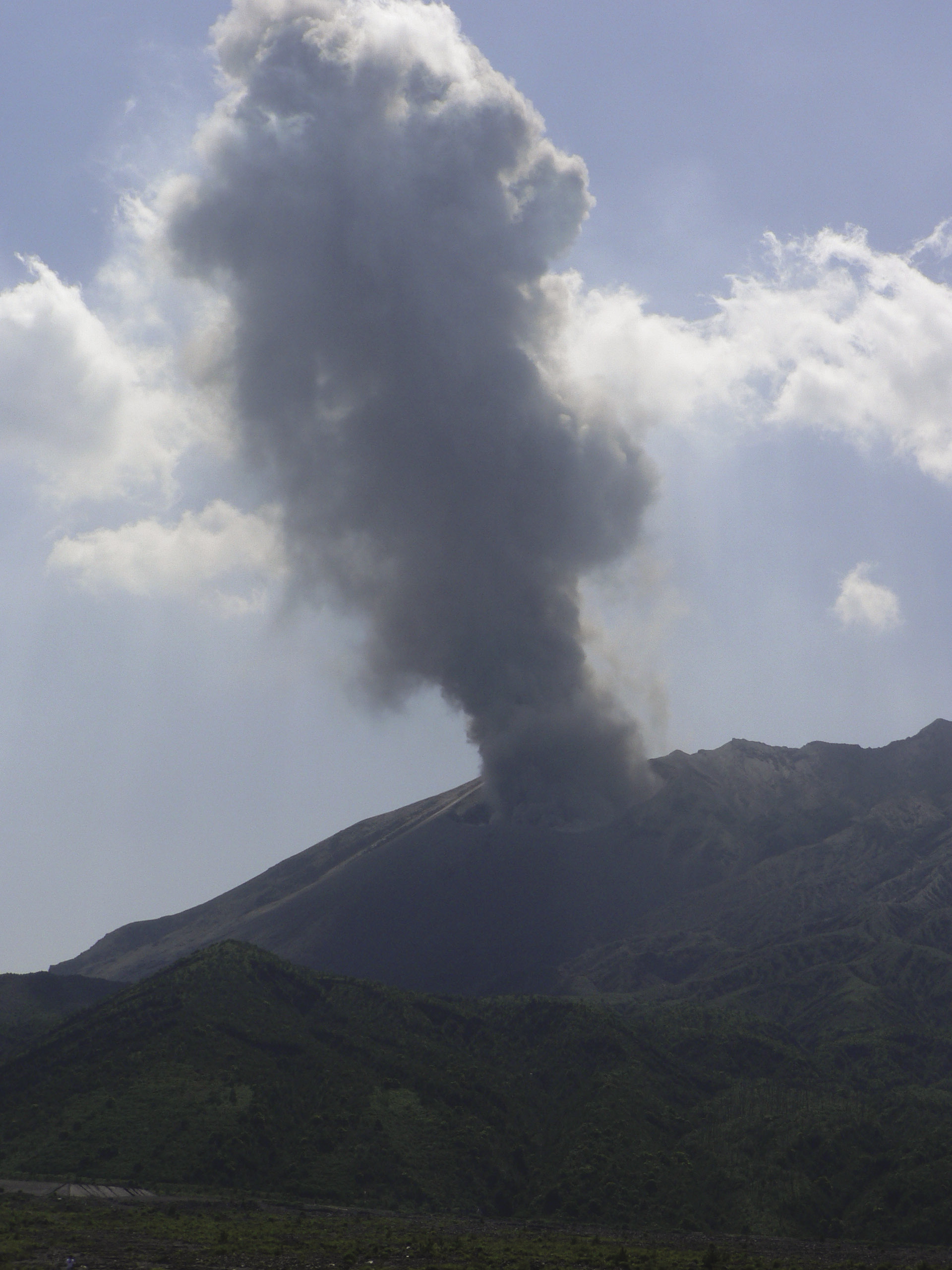 |
|
Figure 1: Right on cue: a small eruption of Showa Crater of Sakurajima volcano on Day 1 of the intra-conference fieldtrip (12 May). Photo: Anja Moebis |
An intra-conference fieldtrip included a visit to the Uenohara Jomon-no-mori archeological centre where a village from the Jomon period (ca. 9.5 ka ago) had been preserved under tephra deposits. The group was then treated to a stunning and apt backdrop for a tephra-based meeting: the Sakurajima volcano has been active since 1955, with more than 8670 eruptions since then. Around 500 eruptions had already taken place in 2010 prior to this visit. Two small vulcanian eruptions took place in Showa crater, by a remarkable coincidence, whilst the group visited the eastern flank of the volcano at the closest point to the active crater (Fig. 1). Furthermore, participants were taken to outcrops of layers of tephras and buried soils dating back 30 ka, to the spectacular Jomon Tenjindan archeological site, and to a magnificent coastal exposure, ~20-30 m high, of the deposits of the voluminous Aira tephra formation dated at ca. 30 ka.
The conference was followed by a three day trip to the Unzen volcano where deposits from the 1990-1995 eruption series, including lava domes, block-and-ash flow deposits, and pyroclasic flow deposits, were seen. Visited sites also included the extremely impressive, ~25-km-wide, Aso caldera and associated deposits, the volcanic vents in central Kyushu, and the volcanoes of Kuij and Yufi-Tsurumi in northeastern Kyushu.
Conclusion
The conference and field trips were remarkable. As one veteran participant remarked, “tephra studies have never been so healthy”. The rise of young tephrochronologists was especially prominent and augurs well for future research and leadership of the discipline. Papers from the meeting are to be published in a volume of Quaternary International that will also commemorate the career of Hiroshi Machida.
reference
Publications
PAGES Magazine articles
2011
Past Global Changes Magazine
Maarten Blaauw1, J. Andrés Christen2 and Workshop Participants
1School of Geography, Archaeology and Palaeoecology, Queen's University Belfast, UK; maarten.blaauw qub.ac.uk
qub.ac.uk
2Centro de Investigación en Matemáticas, Guanajuato, Mexico
San Miguel de Allende, Mexico, 17-21 August 2010
Chronologies are vital for the study of past global change. The strength of conclusions based on paleoenvironmental reconstructions is often constrained by the precision and reliability of their chronologies. However, constructing paleochronologies can be a daunting task requiring a detailed knowledge of statistical techniques and/or dedicated software. For example, radiocarbon dates require calibration, ages might have to be estimated for non-dated core depths, and chronological uncertainties need to be quantified as reliably as possible.
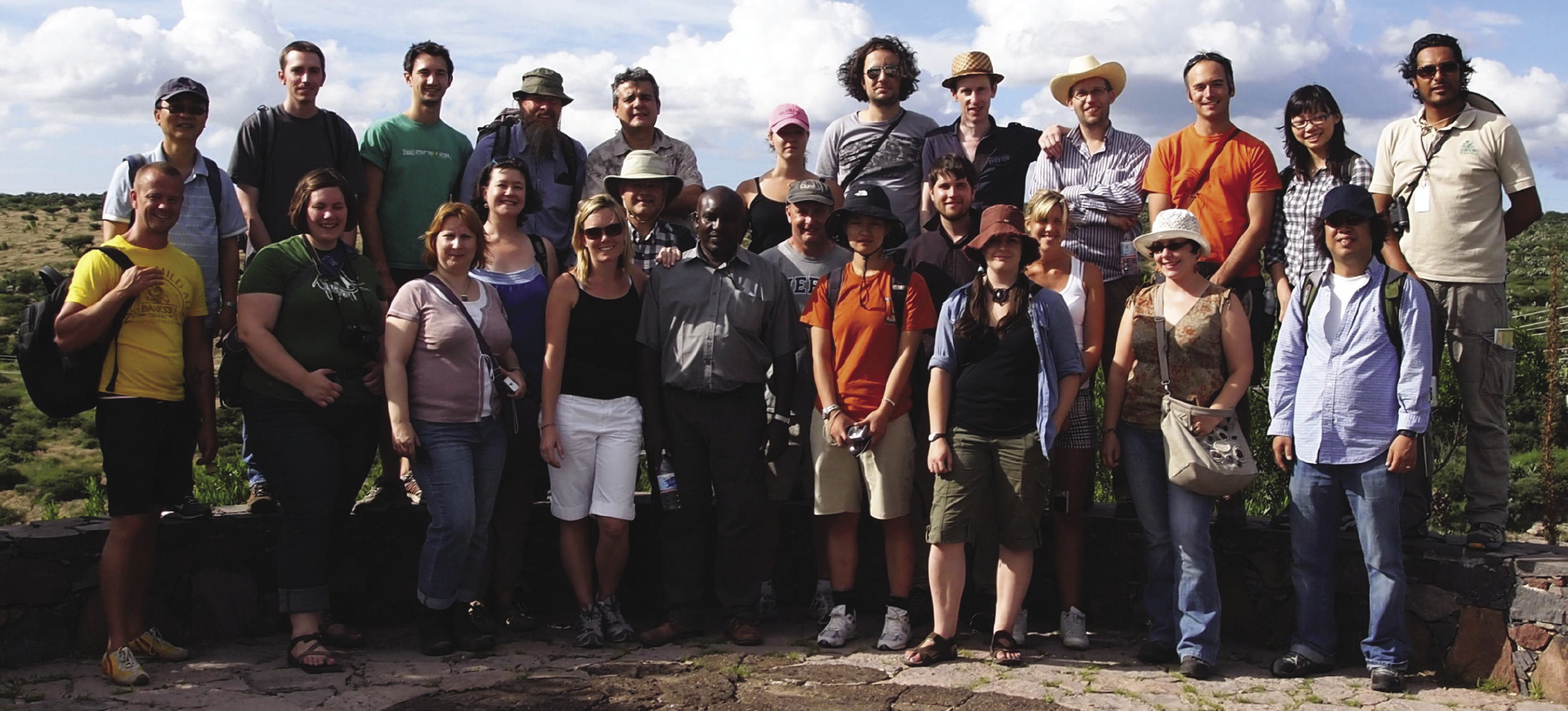 |
|
Figure 1: Workshop participants, with guide Mario (top row, far right) at El Charco del Ingenio ecological reserve in San Miguel de Allende. Photo by Amy Myrbo. |
This summer an educational workshop on paleochronology building was held in San Miguel de Allende, central Mexico. The workshop attracted 27 participants (Fig. 1) from a range of continents (North America, Europe, Asia, Australia, Africa), career stages (from early PhD students to senior faculty), and scientific backgrounds (e.g., 14C dating, modeling, statistics, palynology, oceanography and peat research).
Lectures were given on the theory of radiocarbon calibration, classic and Bayesian sediment age-depth modeling and multi-site interpretations. In addition to the theoretical sessions, much time was devoted to hands-on computer sessions where participants used some of the latest age-modeling software, in particular clam (Blaauw, 2010), OxCal (Bronk Ramsey, 2008), Bchron (Haslett and Parnell, 2008), and Bacon (a recent update to Bpeat; Blaauw and Christen, 2005).
A very interesting poster session was held, with an innovative promenade guided tour by each of the poster presenters. Local cuisine was sampled and excursions were organized to the town's beautiful colonial center and to El Charco Del Ingenio (a huge botanical garden with an impressive range of cacti). Time was also set aside to discuss plans for future collaborations and papers. The workshop started by introducing the ideas and methods of calibrating radiocarbon dates, basic age-depth modeling (e.g., linear interpolation), and Bayesian statistics. This was followed by more advanced topics including models of sediment accumulation, detection and treatment of outlying dates, methods to decide which depths of a core to date next, and multiple-site synthesis methods such as tuning and Bayesian synchroneity tests. Eric Grimm (Illinois State Museum) gave an additional presentation on the Neotoma metadatabase initiative for paleo-data.
The following workshop days were mostly devoted to applying the discussed methods in practice. Next to producing age-models for individual sites, the chronological uncertainties of the proxies themselves were plotted as “ghost graphs” (Blaauw et al., 2007), and several methods were applied to integrate multiple proxy sites. For example, if multiple sites contain the same imprecisely dated tephra, an integrated age estimate of that tephra based on all sites will be more precise and reliable than if calculated from individual sites. Another approach was to test for the synchroneity of environmental proxy events between multiple sites, without resorting to tuning. Of course, participants were given ample time to apply the age-modeling techniques to their own sites.
Information about the workshop, including presentations and software, can be found on http://chrono.qub.ac.uk/blaauw/Workshop/ and http://www.cimat.mx/Eventos/PBW/.
acknowledgements
The workshop organizers wish to thank PAGES and INQUA (under the tephra initiative INTREPID led by Prof. David Lowe, New Zealand) for their financial support of this meeting.
references
Publications
PAGES Magazine articles
2011
Past Global Changes Magazine
Bärbel Hönisch1, D. Schmidt2, S. Barker3 and J. Zachos4
1Lamont-Doherty Earth Observatory of Columbia University, New York, USA; hoenisch ldeo.columbia.edu
ldeo.columbia.edu
2Department of Earth Sciences, University of Bristol, UK
3School of Earth and Ocean Sciences, Cardiff University, UK
4Earth and Planetary Sciences, University of California, Santa Cruz, USA
NSF-PAGES workshop, Santa Catalina Island, USA, 25-29 August 2010
Ocean acidification is a current area of concern for the future functioning of marine ecosystems and ocean biogeochemical cycles. The term "ocean acidification" describes the effects of the oceanic uptake of anthropogenic CO2 including a progressive decrease of seawater-pH. While seawater is not likely to ever become acidic, a reduction in pH and associated carbonate system changes may nevertheless affect ocean biogeochemical processes, particularly biological calcification. However, modern ocean observations and laboratory experiments consider time scales that are too short to reveal the long-term potential of marine organisms to acclimatize or adapt to changing environmental conditions. Furthermore, as experiments focus on a few species or isolated strains, they provide little information on the potential for whole ecosystem changes. The U.S. National Science Foundation (NSF) and PAGES jointly sponsored this workshop to bring together an international group of carbon cycle modelers, carbonate chemistry specialists, and biological, chemical and physical (paleo-) oceanographers to discuss past carbon cycle perturbations and the long-term response of marine organisms to changing conditions, and to provide a geological perspective on future concerns.
Richard Zeebe (University of Hawaii) and Andy Ridgwell (University of Bristol) presented the boundary conditions of past marine carbonate chemistry and stressed the importance of distinguishing between extended periods of high pCO2 with relatively slowly evolving ocean carbonate chemistry, and geologically rapid changes which reflect chemical effects more comparable to the consequence of ongoing CO2 emissions. Acknowledging that the rate of anthropogenic CO2 emissions is probably unparalleled in recent Earth history, Zeebe defined an "ocean acidification event" as one having a duration shorter than about 10 ka. Pleistocene glacial to interglacial transitions and early Cenozoic hyperthermals fall under this definition, but the only event that may be comparable in magnitude of CO2 release is the Paleocene-Eocene Thermal Maximum (PETM).
Daniela Schmidt (University of Bristol), Luc Beaufort (CEREGE) and Sam Gibbs (NOC Southampton) reiterated the importance of the rate of environmental change in assessing the potential for future changes in marine ecosystems. They also focused on the complications associated with attributing biological responses to paleo-ocean acidification. Identifying stressful conditions at the sea surface, which would affect organisms’ biology including calcification, is often indistinguishable from competing factors affecting preservation at the seafloor. Similarly, synergistic effects of temperature or nutrient changes cannot necessarily be separated from shifts in ocean carbonate chemistry. Independent proxy evidence is therefore of utmost importance to identify the physical and chemical boundary conditions that led to physiological and ecological shifts. In addition, the fossil record is biased towards those organisms that secrete skeletal hard parts, in particular marine calcifiers. Ecologically important phyto- and zooplankton are rarely preserved in the sediment and little is known about their fate under past ocean acidification conditions.
Proxies for ocean carbonate chemistry include the boron isotope proxy for seawater-pH, the carbon isotopic composition of alkenones for aqueous [CO2], foraminiferal B/Ca and U/Ca ratios for bottom-water carbonate saturation and carbonate ion concentration, foraminiferal shell weights, and the depth of the carbonate compensation depth to constrain whole-ocean carbonate saturation. Gavin Foster (NOC Southampton) and Jimin Yu (LDEO) presented proxy comparisons and recent advances in paleo-pH reconstructions. They demonstrated that quantitative reconstructions beyond the Pleistocene glacial/interglacial cycles are limited by uncertainties on the elemental and isotopic composition of seawater, and the lack of estimates on a second parameter of the carbon system from the same surface or deep-ocean environment. In addition, most of the established proxies are based on marine carbonates. This is problematic for ocean acidification events in which widespread dissolution of carbonates occurs, such as during the peak of the PETM (when only clays and organic molecules were preserved in many Atlantic sediments) (e.g., Fig. 1). As a novel approach to address this issue, Appy Sluijs (University of Utrecht) presented promising findings on the carbon isotopic composition of organic dinoflagellate cysts as a candidate proxy for aqueous CO2.
The workshop reiterated that no perfect analogue to anthropogenic ocean acidification has yet been found in Earth’s geological record, but that an improved knowledge of the physicochemical boundary conditions in the surface and deep ocean, their rates and magnitudes and biological responses will nevertheless place important constraints on the consequences of current and future ocean acidification. A more comprehensive report on the rates, magnitudes and evidence for paleo-ocean acidification will be published as a peer-reviewed paper.
references
Thomas, E., 1998: The biogeography of the late Paleocene benthic foraminiferal extinction. In: Aubry, M.-P., et al. (Eds), Late Paleocene-early Eocene Biotic and Climatic Events in the Marine and Terrestrial Records, Columbia University Press, 214-243.
Publications
PAGES Magazine articles
2011
Past Global Changes Magazine
Peter Gell1, S. Hausmann2, R. Hall3 and J. Holbrook4
1Centre for Environmental Management, University of Ballarat, Australia; p.gell ballarat.edu.au
ballarat.edu.au
2Department of Geosciences, University of Arkansas, USA
3Department of Biology, Queens University, Canada
4Department of Geology, University of Texas, Arlington, USA
Floodplain Lakes Workshop, Fayetteville, USA, 16-19 September 2010
The evolution of floodplain lakes systems was the theme for a workshop held in Fayetteville, in September 2010. This workshop attracted 30 participants from across the USA, but also from Australia, Russia, Canada, Brazil, and China, with case histories presented from the Murray-Darling, Yangtze, Mississippi and Missouri, Amazon, Rio Manu, Sacramento, White River, Peace-Athabasca and Cauca (Columbia) river systems.
The meeting arose from a gathering at the 3rd PAGES Open Science meeting in Corvallis, Oregon, in 2009 and was set within Focus 4 (“PHAROS”) of PAGES, and particularly aligned with the Theme “Water“ and the associated Working Groups Human Impacts on Lake Ecosystems (LIMPACS) and Land Use and Climate Impacts on Fluvial Systems (LUCIFS).
The presentations spanned three main themes: proxy and chronological development, regional integration and evidence of human impact. The 20 presentations and seven posters covered evidence of accelerated catchment sediment yields, lead and other metal pollutants, and the response of floodplain wetlands to connectivity to the river, regulation of flow, and alteration to water quality. Situated in the Mississippi Basin, the meeting explored in detail the evolution of meander belts in the Missouri River with climate-driven shifts between meandering and braided states, as evident from dated paleo-wetland sequences (Fig. 1).
Considerable discussion was directed towards the particular challenges that are posed by undertaking paleoenvironmental research in such dynamic systems and the need to develop links between researchers working on the history of these systems. Despite recognition of these challenges, study after study showed that sedimentary profiles provided decipherable and informative records of hydroecological changes, and participants identified that a focus on river-wetland interactions holds considerable promise for addressing scientific and management issues of high societal concern. In particular, capacity was seen to engage with those river authorities that were underpinning policies and management decisions only with short-term instrumental records. It was also noted that floodplain sites were of cultural significance as many communities live within floodplains and it is often via rivers that humanity experiences climate variability (droughts and floods).
In line with the goals of PHAROS the meeting initiated discussion on regional upscaling of data. This was exemplified by the presentation of a regional synthesis of wetland change from the Murray Darling Basin. This further stimulated the creation of a network of floodplain lake researchers across North America to roll-start the process of assembling a database of geomorphic and paleolimnological research with a view to providing evidence for regional patterns of change and for identifying regions in need of research.
The organizers received considerable interest in response to the call for papers for a special issue of the Journal of Paleolimnology. The participants also made plans for a biannual meeting at which point the community may be in a position to plan for a substantive review output such as an issue in the Developments in PaleoEnvironmental Research (DPER) series. Further, the focus of several projects on RAMSAR (convention on wetlands of international importance) sites (in Australia, Columbia, USA and Brazil) stimulated a proposal for a future activity focussed on exchanging palaeoecological evidence of change with agencies vested with the responsibility of assessing the natural ecological character of listed wetlands and setting limits of acceptable change.
Publications
PAGES Magazine articles
2011
Past Global Changes Magazine
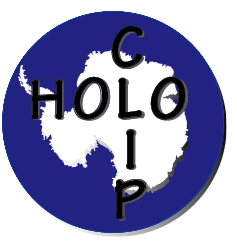 |
Barbara Stenni1, X. Crosta2, H. Oerter3, C. Escutia Dotti4, H. Renssen5, H. Goosse6, J. Pike7 and R.B. Dunbar8
1Department of Geosciences, University of Trieste, Italy; stenni units.it
units.it
2UMR-CNRS 5805 EPOC, University of Bordeaux 1, Talence, France
3AWI, Bremerhaven, Germany
4Instituto Andaluz de Ciencias de la Tierra, CSIC-University of Granada, Spain
5Faculty of Earth and Life Sciences, VU University, Amsterdam, Netherlands
6Institut d’Astronomie et de Géophysique G. Lemaître, Université catholique de Louvain, Louvain-la-Neuve, Belgium
7School of Earth and Ocean Sciences, Cardiff University, United Kingdom
8Environmental Earth System Science, Stanford University, USA
HOLOCLIP kick-off meeting , Université Pierre et Marie Curie, Paris, 29-30 June 2010
Southern Hemisphere (SH) high-latitudes are challenging places to document and understand the mechanisms of natural climate variability: (1) the regional climate response involves complex and poorly documented interactions involving all the components of the climate system; (2) temperature changes are amplified compared to low latitude environments; and (3) Antarctica and its surroundings are characterized by a strong regional variability. These regional differences are obvious during the recent instrumental period, which depicts a large warming over western Antarctica during the last 50 years while no clear trends were observed for other Antarctic regions. Regional differences have also been highlighted over the course of the Holocene from geological and glacial records, supported by model experiments.
In the framework of the European Science Foundation (ESF) PolarCLIMATE program (http://www.esf.org/research-areas/polar-sciences/polarclimate.html), HOLOCLIP aims to bring together the ice core, marine sediment core and modeling communities to study the processes linking the different components of the climate system and linking the climatic response to the external forcing over the Holocene. Key areas of the Antarctic Ice Sheet and their marine surroundings have been selected (Fig. 1).
The objectives of this Joint Research Project are multiple and can be grouped as follows:
1. To validate and calibrate our proxies through investigation of the modern systems, to improve understanding of the tools that we currently use for climatic reconstructions.
2. To document changes in the different components of the Holocene climate system in terms of amplitudes, frequencies and timing, using a multi-proxy approach.
3. To document the regional heterogeneity of the different climate components over the Holocene by investigating several marine cores from the Antarctic continental margin and ice cores from the ice sheet and integrating the results in climate models via assimilation techniques.
4. To evaluate relationships between the different components / parameters, through a detailed comparison of marine and ice-core records, to better document the interactions among atmosphere-cryosphere-ocean.
5. To quantify the main forcing factors and to detect the regional climate sensitivity to these forcings.
6. To document the feedbacks between different system components.
LOCEAN (Laboratoire d’Océanographie et du Climat: Expérimentation et Approches Numériques) at University Pierre and Marie Curie, hosted the HOLOCLIP kick-off meeting. Nineteen scientists from the ice core, sediment core and climate modeling communities gathered to discuss available data, plan activities and coordinate the scientific teams for the next year.
Each project partner presented their main contribution to HOLOCLIP to provide an overview of the available data and the plans for new data to be obtained (Fig. 1). Climate modelers presented the model (LOVECLIM) that will be used to perform transient and snapshot simulations.
The actions to be performed before the end of the first year of the project are:
- Laboratory measurements on ice and sediment cores to produce additional high-resolution data sets.
- The compilation of a database hosted on the project website (www.holoclip.org) to facilitate a number of synthesis
products.
- Data synthesis of Antarctic temperatures, sea-surface temperatures and sea ice cover at five time slices (8, 6, 4, 2, 0 ka BP). Data synthesis will serve as a ground truth for climate model evaluation and data assimilation.
- Exchange of samples among partners (both modern and fossil) to achieve the best calibration and paleo-reconstructions possible.
- Exchange of young scientists among partners for training.
ESF-HOLOCLIP is funded by national contributions from Italy, France, Germany, Spain, The Netherlands, Belgium and the United Kingdom, with Stanford University as an associated partner.
Publications
PAGES Magazine articles
2011
Past Global Changes Magazine
Takeshi Nakatsuka and Masaki Sano
Graduate School of Environmental Studies, Nagoya University, Japan; nakatsuka.takeshi f.mbox.nagoya-u.ac.jp
f.mbox.nagoya-u.ac.jp
Nagoya, Japan, 26-27 August 2010
Asia is an important region in the PAGES 2k Network for the reconstruction of climate of the last 2000 years. Around 60% of people in the world live in Asia and major climate phenomena, such as large-scale monsoon systems, affect their livelihood regionally and the climate system globally. However, paleoclimate data of last two millennia have not been integrated well in Asia until now.
For the reconstruction of paleoclimate with annual or sub-annual time resolution, tree rings are one of the most advantageous climate archives. Many long tree-ring chronologies have been established in cold and dry Asia such as the Tibetan plateau and Gobi desert. Unlike most higher latitude regions, tree-ring studies in tropical and subtropical Asia are constrained by the additional challenge of harboring only few tree species that form annual rings. However, dendrochronologists have recently managed to overcome this limitation by systematically searching for ring-forming and climate-sensitive tree species, and have successfully developed the first tree-ring based reconstructions of past precipitation and temperature in humid and temperate Asia, including Indochina, Taiwan, and Japan.
Furthermore, historical documents, especially from China, provide exceptionally long records of past climate with a seasonal resolution that can reach back to more than two millennia. Lake and marine sediment studies have also resulted in important data sets of high-resolution climate variations in Asia. A growing number of speleothems records from China and many other countries reflect past hydroclimate on various time scales. Ice cores from the mountains and corals from coastal regions provide further unique data sets on climate dynamics from land and ocean.
The first Asia 2k Regional Workshop was designed to review the state of paleoclimate science in Asia towards the synthesis of various kinds of proxy-based Asian climate reconstructions during last two millennia.
A total of 73 scientists and students, including the 15 invited international scientists, attended this workshop with 24 oral and 26 poster presentations. Oral sessions consisted of keynotes by members of the scientific committee (E. Cook, H. Borgaonkar, B. Buckley and O. Solomina), followed by presentations on state-of-the-art proxy-based reconstructions of Asian paleoclimate using tree rings, ice cores, stalagmites, lake sediments, marine archives and historical documents together with climate modeling. Proxy, region and time range covered by all oral presentations are illustrated in Fig.1. All abstracts and presentations can be viewed on the Asia 2k website (http://pastglobalchanges.org/ini/wg/asia2k/products).
The tree-ring session started with the presentation of a gridded reconstruction of the Palmer Drought Severity Index (Monsoon Asia Drought Atlas) using a continental scale database of tree-ring width ((1) E. Cook in Fig.1, same hereafter). Tree-ring chronologies did not only reveal long climate histories in the cold and dry Asia ((2) Y. Liu, (4) R. Yadav, (5) J. Palmer, (11) O. Solomina) but they also demonstrated the value of tree rings for climate reconstructions in humid and temperate Asia ((3) H. Borgaonkar, (6) B. Buckley, (7) W. Wright, (8) K. Yasue, (9) Y. Hoshino, (10) T. Nakatsuka). After a comprehensive review of Asian mountainous ice core studies ((12) K. Fijita), new speleothem records were presented from South and Southeast Asia ((13) V. M. Padmakumari, (14) C. Muangsong). Lake and marine sediment records presented ((15) Shankar, (16) Yamada, (17) M-T. Chen) covered more than 2000 years with decadal time resolutions. Finally, various climate records were presented from Chinese historical documents ((19) Q. Ge, (20) T. Nagano).
After the workshop, the Scientific Committee and other workshop participants discussed future directions of the Asia 2k Working Group in detail and tentatively concluded that the second Asia 2k workshop should be held in the fall of 2011 in order to conduct a training course for analyses and compilation of past climate data sets towards the 2k paleoclimate synthesis in Asia.
Publications
PAGES Magazine articles
2011
Past Global Changes Magazine
Marcela Tonello1 and Antonio Maldonado2
1Department of Biology, University of Mar del Plata, Argentina; mtonello mdp.edu.ar
mdp.edu.ar
2Laboratory of Palaecology, Centre for Advanced Studies in Arid Zones, La Serena, Chile
Valdivia, Chile, 23-27 October 2010
This educational course on quantitative paleoecology and South American climatology was organized as a pre-conference event prior to a major international PAGES symposium in Valdivia (see below). The objective of this course was to impart a high level of first-hand knowledge to early career researchers from Latin American countries working in paleoecology and paleoclimatology. The course topics had been selected on the basis of students’ enquires that followed the “International Workshop on Methods in Quaternary Palaeoecology” held in La Serena in 2007 (Maldonado and Latorre, 2008).
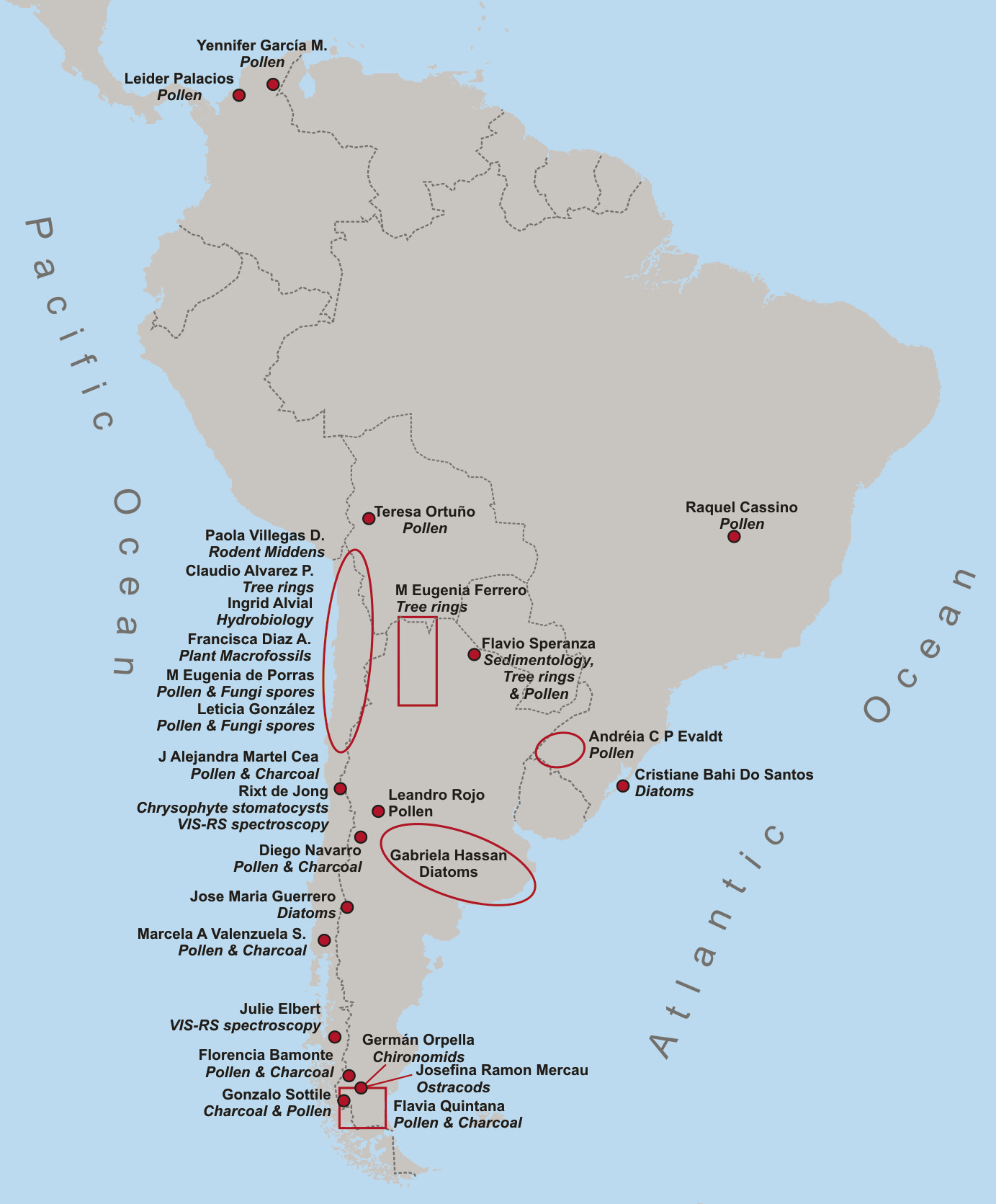 |
|
Figure 1: Twenty-seven participants from Argentina, Chile, Brazil, Colombia, Switzerland and Bolivia attended the workshop. Their research areas and used proxies are indicated in the map above. |
A total of 27 participants from Argentina (11), Chile (8), Brazil (3), Colombia (2), Switzerland (2) and Bolivia (1) were chosen from over 70 applicants. All participants were graduate students or young post-doctoral scientists working with a variety of different paleo-proxies (pollen, diatoms, tree rings, plant macrofossils, etc.) on projects across South America (Fig. 1).
The lectures on the first three days of the course were given by Prof. John Birks (University of Bergen) on quantitative paleoecology and environmental reconstructions, including an overview of the major numerical methods such as ordination analysis, analysis of stratigraphical data, data calibration and transfer functions. The last two days, Prof. René Garreaud (University of Chile) gave a presentation on South American climatology including the basic climate dynamics, the fundamental statistical tools applied in climatology and the general concepts of South American climate. After the lectures, the participants had the opportunity to discuss their own data with the lecturers and immediately apply their newly acquired knowledge.
Given that the course topics were highly relevant to the general PAGES objectives, all participants also attended the II International Symposium “Reconstructing Climate Variations in South America and the Antarctic Peninsula over the last 2000 years” (LOTRED-SA) the following week. At the LOTRED-SA conference, they met experienced researchers working on different projects in South America and had the opportunity to exchange and discuss ideas with them.
Initiatives like this PAGES supported educational meeting, offer emerging South American researchers the chance to gain access to the finest knowledge and expertise.
The conveners wish to thank Prof. John Birks and Prof. René Garreaud for their willingness to deliver the course and PAGES, University of La Serena, Centre for Advanced Studies in Arid Zones (CEAZA), Southern University of Chile (UACh) and Center for Scientific Studies (CECS) for financial and logistical support.
references
Publications
PAGES Magazine articles
2011
PAGES news
Duncan A. Christie1 and Andrés Rivera2,3
1Facutly of Forest Sciences and Natural Resources, Universidad Austral de Chile, Valdivia; duncanchristieb gmail.com
gmail.com
2Glaciology, Center for Scientific Studies (CECS), Valdivia, Chile
3Geography Department, University of Chile, Santiago; arivera cecs.cl
cecs.cl
Valdivia, Chile, 27-30 October 2010
The 2nd International Symposium "Reconstructing Climate Variations in South America and the Antarctic Peninsula over the last 2000 years" was part of the PAGES research initiative LOTRED-SA (Long-Term climate REconstruction and Dynamics of South America). This symposium was organized by the Centro de Estudios Científicos (CECS) and the School of Forestry and Natural Resources (Universidad Austral de Chile). Nearly 200 scientists from 15 countries (mainly from Chile, Argentina, Brazil, Colombia, Switzerland and USA) came together for oral and poster presentations, mainly related to new high-resolution paleoclimate studies in South America and the Antarctic Peninsula. Prior to the Symposium, a graduate international course “South American Climatology and Quantitative High-Resolution Climate Reconstructions in Paleoecology” took place (see PAGES news 19(1) for a report). The 2nd International Symposium was the follow-up of the 2006 Malargüe-PAGES Meeting in Argentina, which had led to a special issue of
The goal of the 2010 meeting was to gather experts from different fields in climate dynamics, paleoclimatology (proxy data and models) and glaciology, in order to review recent discoveries, discuss new data sets, evaluate the interpretation of proxy data, and search for new calibration and quantification techniques of proxy data sets in South America and the Antarctic Peninsula. The long-term goal of this collaborative meeting was to produce a more comprehensive understanding of regional forced and unforced climate variability, as well as environmental changes during the past millennia. The main idea is to improve the production of gridded data sets of climate variables from high-resolution multi-proxy time series.
This conference brought together senior and young scientists working on tree rings, glacier records, lake and marine sediments, geomorphology, ice cores, historical documents, speleothems and other paleoclimate archives. All these experts were interested in paleoclimatic reconstructions for different regions of tropical, extra-tropical and sub-Antarctic South America and the Antarctic Peninsula. The meeting also greatly benefited from the participation of climatologists working on modeling of the present climate of South America, providing a dynamically meaningful and physically plausible framework for the interpretation of past environmental records. One of the most exciting outcomes of this conference was the significant assistance it provided to young scientists and the great enthusiasm demonstrated by all in attendance.
At present we are working on a Special Issue of Climate of the Past, which will include the most outstanding contributions presented in the symposium. This special issue will provide an updated and comprehensive outline of ongoing research on this topic.
Guidelines for collaboration and contributions to LOTRED-SA are available at www.pages-igbp.org/workinggroups/lotred-sa or by contacting one of the coordinators: Ricardo Villalba (ricardo lab.cricyt.edu.ar), Martin Grosjean (grosjean
lab.cricyt.edu.ar), Martin Grosjean (grosjean giub.unibe.ch). For detailed information about this Symposium, and photos and videos of the conference presentations, please visit www.cecs.cl/pages2010/.
giub.unibe.ch). For detailed information about this Symposium, and photos and videos of the conference presentations, please visit www.cecs.cl/pages2010/.
references
Rivera, A., Bravo, C. and Sylwester, D., 2010: 20th century strong retreat of glaciar Jorge Montt unburied more than 250 year old trees destroyed during the LIttle Ice Age, In: Reconstructing Climate Variations in South America and the Antarctic Peninsula over the last 2000 years, II International Symposium, Abstract # 191, Valdivia, Chile.
